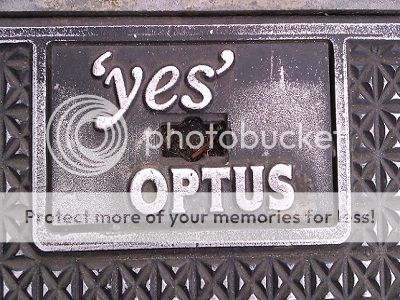Yes, This is about manhole covers.
- PMG: Postmaster General (1901-1975)
Before federation, the control of telephony in Australia was under the control of the states' and territories'
governments. This led to a general sort of mish-mash of standards for telephony in Australia and it wasn't until 1901 that the Federal Postmaster-General's Department took control.The first telephone exchange in Australia started operations in 1880 in Melbourne, with 44 lines and could be connected by a single human operator. Telephone operators were still in use at the time of federation and it wasn't until 1912 that the first automatic exchanges were installed.
Postmaster-General's Department's plates were seen all over Australia and owing to the fact that steel plate is incredibly durable, sights like this are not uncommon, even 38 years after the Postmaster-General's Department was split into the Australian Postal Commission (Australia Post) and the Australian Telecommunications Commission (Telecom).
PMG did not stand for Public Money Grabbers, Parramatta Monkey Gang or Pigs Meat & Gravy, as some sources on the internet suggest that it does.
- Telecom I (1975-1993)
The Australian Telecommunications Commission (trading as Telecom) was the half of the Parramatta Monkey Gang responsible for telephony. This rounded T logo I think supposed to suggest the two ends of the receiver of an older style telephone, I assume. It makes a great deal of sense that the logo for the telephony corporation half should be a T and the postal corporation should be a P.
- Telecom II (1993-1995) & Telstra (1995 - present)
Telecom Australia adopted this logo in 1993 to coincide with the opening up of the Telecom MobileNet service. Corporately the company was moving towards a more profitable existence and whilst on the outside it had given itself a new lick of paint (and eventually a new name, from Telecom Australia to Telstra), on the inside it was shedding jobs under a then Keating Government "rationalisation" push.
The official explanation for this logo is that it's supposed to be a T and a stylised satellite dish.
By the time that the corporation was privatised, most of the tweaking with Telstra's logos was complete. Eventually the vertical stroke on the T would be eliminated but the manhole covers don't really show that much of a distinction.
- Optus (2001 - 2013)
This brings me to Optus. The "yes" logo (which was the second logo of the company) was applied to everything which the firm owned, which admittedly wasn't at first very much. Optus started by paying rental fees for the use of Telstra's cooper wire network. I assume that these manhole covers are either for their own cable TV and internet network or as landlines for their mobile network.
- NBN Co (2009 - present)
The National Broadband Network (which was a First Rudd Ministry policy, designed to correct the mistakes of the First Howard Ministry), is only a fairly new thing. I haven't as yet seen any steel chequerplate for the NBN, but I have found two concrete manhole covers with plastic inserts in. To be honest, I don't particularly see the little plastic thing lasting long because the plastic is liable to become brittle and old, unlike a steel plate or cast iron cover (like the PMG), however the concrete could very last for millennia as evidenced by some manhole covers in Rome which date from the 1st Century AD.
I expected to find at least one Optus cover when they had their first logo and maybe we'll start to see some new ones now they they've changed their logo again. Telephony companies like Vodafone are unlikely to have manhole covers because they offer wireless and broadband via 3G and 4G networks.
It's still interesting to look down at the things which we pass over every day without a second thought. They form part of the furniture of our lives as much as other things, even though we might fail to admit it.






No comments:
Post a Comment